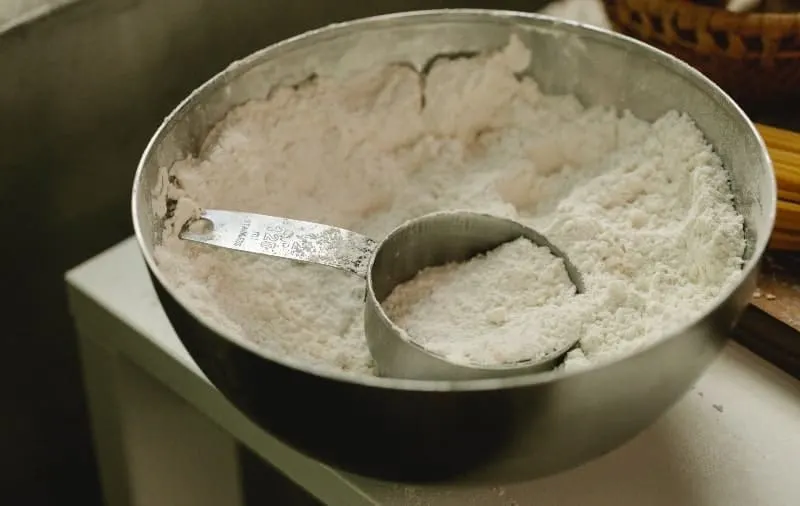There are quite a few different types of flour, so to the beginner baker, it can be daunting and confusing at first. Fortunately, once you get to understand the basic flours (plain, bread, cake, pastry, self-rising, whole wheat, etc. – there are plenty of different types and variations, but these are the basics), you’ll know what each is used for and what applications they fit into.
Cake flour is not the same as plain flour (also known as all-purpose). Cake flour is specifically made for cakes, so it has a lower protein content and is milled finer, which results in a softer and lighter texture. Plain flour can be used to make almost anything that uses flour, including a cake.
Plain flour is multi-purpose. It’s a jack of all trades, but a master of none, so it’s a good substitute if you’re ever out of a specific flour. However, plain flour still isn’t the best choice to go for since it’s still different from cake flour.
Cake flour is made purely to be used for cakes, so that’s what works best. Using plain flour in place of cake flour isn’t the end of the world, but it may produce more inferior results than what you’d get with cake flour.
Let’s take a deeper look into the differences between these two types of flour.
What’s The Difference Between Cake Flour And Plain Flour?
Cake Flour Has A Lower Protein Content
The lower protein content of cake flour allows it to produce much softer cakes. Most cake flour contains a protein content anywhere from 7-10%. When looking for cake flour, the best range would be 7-8% for something that’s very soft with little to no chew. The majority of other flour types, like plain and bread flour, will contain upwards of 10% protein.
When making almost any baked good, it’s important to take this protein content into consideration. You see, this protein is what forms gluten, which is what makes dough elastic and the food chewy. For example, sourdough bread often uses mostly high protein bread flour, which gives it its chewy characteristic. You don’t need or want chewy cake, so it’s smart to use flour with less protein.
Although you need gluten for a good cake, you don’t want to develop too much of it. This is why a cake flour with a 7-10% protein content is optimal. It’s still going to produce gluten, but it’s unlikely to create so much that the cake becomes chewy or tough.
When comparing this with plain flour, which generally has around 10-12% protein, it’s much more appropriate to use cake flour for a better-textured cake.
Cake Flour Is Bleached
Cake flour isn’t bleached everywhere in the world, but when manufacturers are allowed to bleach it, they generally will. Now, although bleaching brightens the color of the flour, it also serves to help make it better for cakes.
Yes, bleaching flour may lead to health issues, so it’s completely fine if you don’t want to use it, but there are benefits to making cake with cake flour. As described in a Serious Eats article here, bleached cake flour can help cakes to develop a good crumb, stay moist, and inhibit some browning, which is great if you’re worried about burning.
If you’re in the UK or EU, no type of flour will be bleached, since it’s illegal to bleach flour, so it’s not something you’ll come across.
Plain flour generally isn’t bleached, but it can be found bleached in some countries.
Cake Flour Is Finer
Cake flour is milled to a finer grade than regular plain flour to make it better suited for cakes. This fine mill helps to create softer and lighter textured baked goods, which means that it’s great for making any kind of cake.
Plain flour, on the other hand, is just milled to a standard grade as it’s not made for any specific purpose.
Can You Use Plain Flour Instead Of Cake Flour?
Plain flour can be used for the same purposes as cake flour, but that doesn’t mean that it will do as good of a job.
Since plain flour contains more protein, it’ll naturally create more gluten and lead to a chewier cake. As you know, cakes are generally light and fluffy, which brings a great mouthfeel when eating the cake. With plain flour, it’s fair to say that the mouthfeel you get just won’t be the same.
Whilst using plain flour isn’t going to give you the best results, you can still improve that by mixing in some cornstarch (the white powder), otherwise known as cornflour depending on where you live.
Since cornstarch is gluten-free, it can help to lower the protein content of the flour, which can lead to a softer cake. Although this isn’t the same as standard cake flour, it’s still a very good substitute.
How To Make A Cake Flour Substitute
You’ll be glad to know that making a cake flour substitute isn’t difficult at all and it won’t take you much time. It simply involves plain flour and cornstarch.
Here’s what you’ll need for a cake flour substitute:
- 120g (1 cup) plain (all-purpose) flour
- 15g (2 Tbsp) cornstarch
You want to find out how much cake flour you’d need and measure out these ingredients to fit the recipe.
To get these ingredients mixed properly, you’ll want to first mix them together in a large bowl before sifting them together once or twice. This allows the ingredients to be evenly combined so they can produce the best results.

